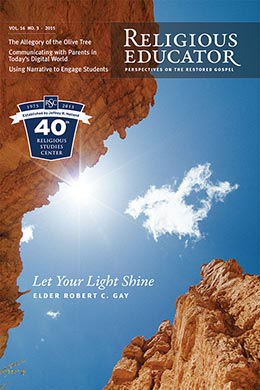Communicating with Parents in Today’s Digital World
Po Nien (Felipe) Chou
Po Nien (Felipe) Chou, "Communicating with Parents in Today's Digital World," Religious Educator 16, no. 3 (2015): 58–75.
Po Nien (Felipe) Chou (ChouPN@ldschurch.org) was a religious educator and manager of the Office of Research, Evaluation, and Assessment for the Seminaries and Institutes of The Church of Jesus Christ of Latter-day Saints when this article was published.
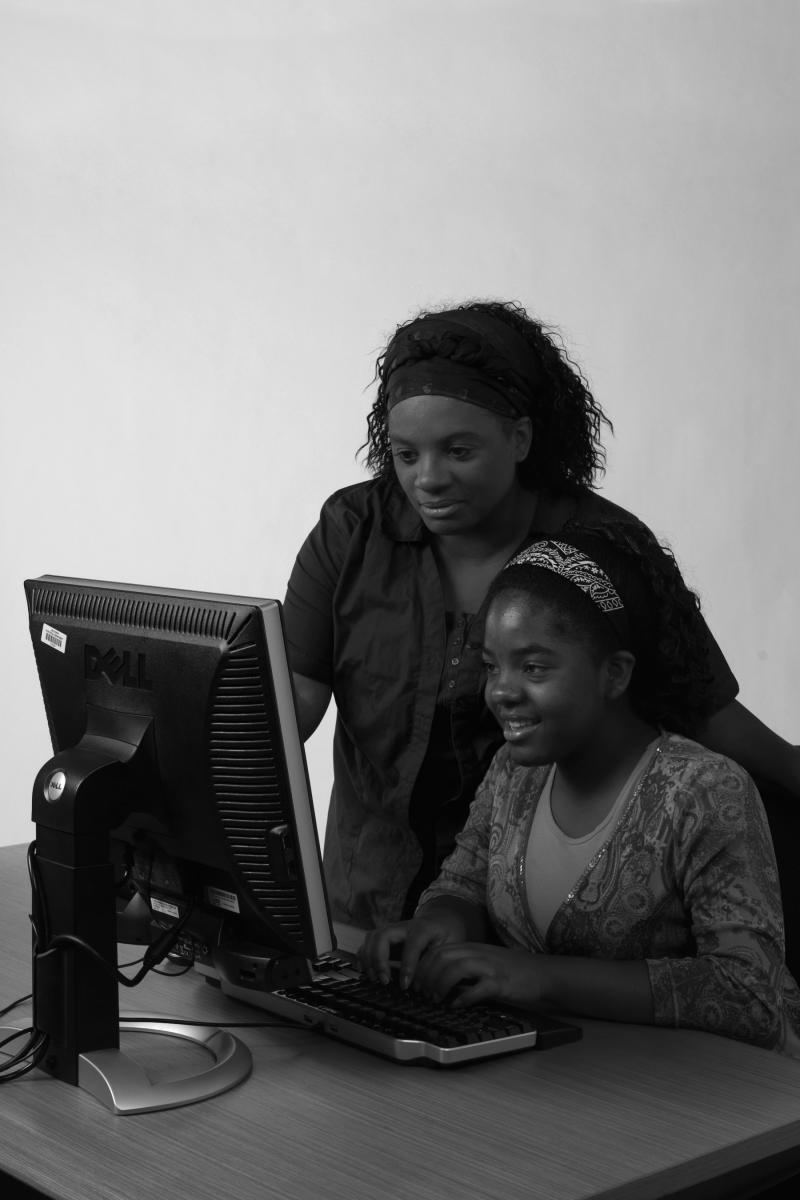 Elder David A. Bednar taught that "inspired technological and communication innovations... have come forth in this decisive dispensation,... and how we appropriately use these powerful tools to advance the work of salvation" should be considered in our days.
Elder David A. Bednar taught that "inspired technological and communication innovations... have come forth in this decisive dispensation,... and how we appropriately use these powerful tools to advance the work of salvation" should be considered in our days.
Recently, I received a couple of emails from my children’s seminary teachers. One was in regards to the seminary’s attendance policy, and the other outlined the new seminary graduation requirements. These Seminaries and Institutes (S&I) teachers utilized modern tools to increase communication between the seminary and the home. A study by L. Grant suggested there were benefits in enhancing communication between the home and the school, as well as utilizing technology to augment this communication.[1] Elder David A. Bednar of the Quorum of the Twelve Apostles taught that “inspired technological and communication innovations . . . have come forth in this decisive dispensation, . . . and how we appropriately use these powerful tools to advance the work of salvation” should be considered in our days.[2]
How should S&I leaders and teachers use these tools to communicate with parents in today’s digital world? This article considers insights from religious educators and parents in regards to the preferred mode and frequency of communication between the seminary and the home, how parents value and use electronic communication, and challenges experienced pertaining to communication with parents in this digital age. As noted in our S&I materials, S&I “leaders and teachers effectively manage information when they gather, organize, analyze, communicate, and use information to make wise decisions.”[3] S&I leaders and teachers can (and should) seek to communicate effectively with parents by utilizing modern communication tools available to us today.
Prophetic Teachings Regarding Communication in Our Day
About forty years ago, President Spencer W. Kimball said, “I believe that the Lord is anxious to put into our hands inventions of which we laymen have hardly had a glimpse. . . . These [are] miracles of communication.”[4] Today’s digital communication tools are indeed modern-day miracles compared to tools of past years. Elder L. Tom Perry of the Quorum of the Twelve Apostles noted that “the future would bring greater reliance on technology” and that we should give attention to both the message “and the way it is delivered—that is, the technology that’s used.”[5] S&I leaders and teachers should understand that what we communicate is just as important as how we communicate.
President Gordon B. Hinckley noted that “as the work of the Lord expands . . . communication is the sinew that binds the Church as one great family. Between those facilities which are now available and those which are on the horizon, we shall be able to converse one with another according to the needs and circumstances of the time.”[6] The Lord has provided S&I leaders and teachers with tools to meet our needs and circumstances as we strive to communicate with parents. We should seek the Spirit when communicating with others. However, “although the Spirit is the greatest aid to communication, there a number of activities and techniques we can use that will also help us communicate better with [others].”[7] There are also many modes and forms of communication. President Thomas S. Monson said that “the ability to communicate is not something we are born with. We have to learn it and earn it.”[8] Best practices are shared in this article to help religious educators communicate better with parents in today’s digital world.
Communication between S&I and the Home
Those who labor in the S&I programs of the Church seek to “administer our programs and resources appropriately” for the purpose of “assist[ing] parents in their responsibility to strengthen their families.”[9] To help strengthen families, “[S&I] leaders and teachers can . . . assist parents by communicating pertinent information about their child’s performance in class, such as attendance, punctuality, conduct, academic performance, or credit.”[10] Elder M. Russell Ballard of the Quorum of the Twelve Apostles taught that “there is a desperate need for parents, leaders, and teachers to help our youth learn to understand, love, value, and live the standards of the gospel.”[11]
The content of the information provided to parents has generally remained the same over the years, but how teachers communicate with parents today has changed significantly with the advent of email as well as the proliferation of electronic and mobile devices. Still, it is important to recognize that effective communication is crucial and that “despite technological advances in communication—radio, telephones, television, and satellites—our communication with those we know best is often as difficult as it ever has been.”[12]
President Spencer W. Kimball, while he was Acting President of the Quorum of the Twelve, used the following story to illustrate the importance of maintaining communication lines:
In South America we saw once an example of broken communication lines. . . . [There] was a series of poles on which were strung the wires for telephone communication to the world. . . . Someone had carelessly thrown a lighted cigarette from a car window. It had ignited the grass, the telephone communications . . . and communication was down. . . . Telephone lines and telephone poles are a little like people. . . . [They] are designed to be firm and stout and to give support; but in many cases they are leaning and swaying and sagging until communications are greatly impaired, if not actually cut off.[13]
To ensure that communication lines are working properly, “seminary leaders and teachers should periodically issue report cards . . . [and] should be available and responsive to questions and concerns from parents.”[14] This helps to update parents and to maintain an open line of communication between the S&I teachers and the parents. An article by the Church suggests that “when a child does bring home a poor report card,” parents could have a meaningful conversation and schedule “a conference with the teacher . . . [to] focus their attention on a common problem and work together to find a solution.”[15] “In addition, relationships with parents can be greatly strengthened by occasional phone calls, letters, or conversations that express deserved praise and commendation.”[16] S&I leaders and teachers should “treasure the divine gift of communication, and . . . use it wisely to build and to assist others.”[17]
A Seminary Communication Pilot
A pilot study was conducted to understand and evaluate the communication between seminary teachers and parents of seminary students. Questions answered in this study included the following:
- What mode and frequency of communication do parents prefer with their child’s seminary teacher?
- How do parents use and value email communication from their child’s seminary teacher?
- What are some of the challenges regarding email communication with parents?
This pilot study included the faculty of four released-time seminary programs (three in Utah and one in Arizona), one coordinator in the United States (in Massachusetts), and one coordinator outside the United States (in Brazil). These two coordinators had approximately 15–20 stake-called teachers participating in this pilot.
During this three-month pilot, seminary teachers provided parents with highlights of key concepts or principles of the seminary lesson covered in class that week, along with a couple of discussion questions to help encourage gospel conversations at home. Level of participation varied based on location and assignment. For example, some teachers sent emails daily instead of weekly, and the length of communication varied from a couple sentences to several emails. There was also delayed and reduced participation by stake-called teachers compared to released-time teachers. Towards the end of this pilot, telephone interviews with S&I teachers and online survey data from 176 parents helped to capture their experience and feedback (see figure 1). Findings based on the analysis of the data could benefit religious educators throughout the world.
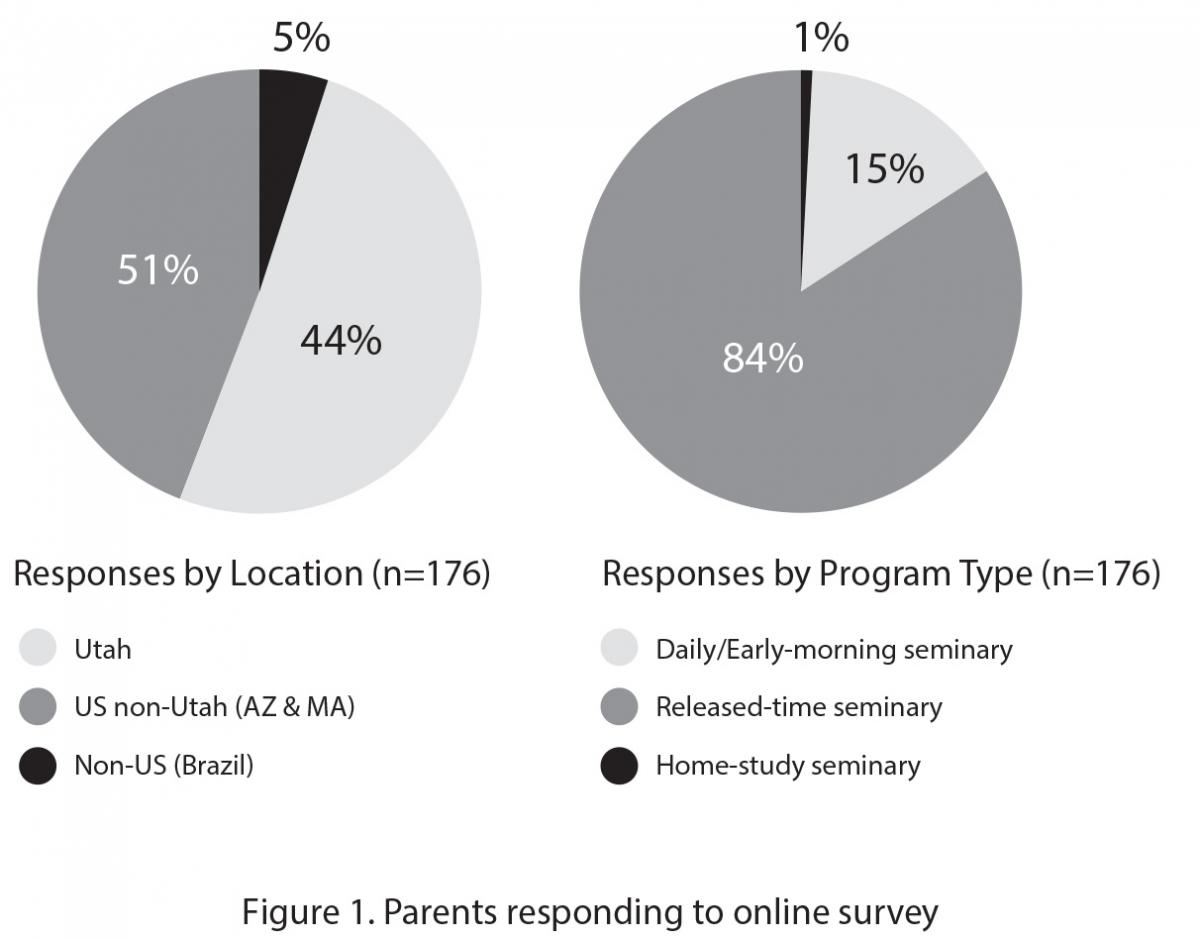
The online survey was only available in English, which may have resulted in the low response rate from Portuguese-speaking parents in Brazil. The majority of responses came from parents who had children in released-time programs in the United States (84 percent), and very limited data was received from parents with children in daily or home-study programs. As such, findings may not be generalizable to all daily and home-study programs in or outside the United States. In addition, most released-time teachers indicated that almost all parents were active members of the Church, and findings may not be generalizable to populations that include parents who are non-members or less-active members of the Church. Interview data was gathered from S&I employees only, and no primary data was gathered from stake-called teachers. Notwithstanding these limitations, this study provided valuable insights.
Mode and Frequency of Communication
The average length of emails sent by seminary teachers was a couple of paragraphs, typically providing a summary of the week’s lesson and a couple of discussion questions. A few emails were longer and included additional information, such as general announcements, reminders regarding upcoming events, and so forth. One parent noted that generally, each email “gives the information needed without being too long. Highlighting the subject area [or] scripture references helps.” When accounting for both mode and frequency of parents’ communication with their child’s seminary teacher, table 1 shows that parents generally preferred an email once a week (67 percent), followed by a face-to-face communication a few times a year (56 percent), and telephone contact a few times a year (29 percent). One parent summarized it as follows: “I visit with the [seminary] teacher once or twice a year at the parent-teacher conference, otherwise a short weekly update by email or text is sufficient.”
Many parents received their emails on their mobile devices, such as their cell phone or tablet. A New Era article by Brad and Russell Wilcox noted that it is important to remember that “like all communication tools, cell phones with text messaging capabilities can be positive or negative depending on how they are used. . . . Like e-mailing, texting can be a wonderful way to communicate and build relationships, but it’s not the relationship itself.”[18] To this end, S&I leaders and teachers should recognize that besides a weekly email, parents also indicated they would like face-to-face communication a few times a year.
Table 1: Preferred Communication Mode and Frequency
|
Daily |
A few times a week |
Once a week |
A few times a month |
Once a month |
A few times a year |
Once a year |
None |
|
|
Face-to-face (n=141) |
3% |
1% |
7% |
3% |
3% |
56% |
22% |
5% |
|
Telephone (n=120) |
2% |
1% |
1% |
2% |
3% |
29% |
13% |
49% |
|
(n=168) |
6% |
5% |
67% |
11% |
6% |
3% |
0% |
2% |
|
Postal mail (n=118) |
0% |
0% |
0% |
0% |
4% |
15% |
11% |
70% |
Note: n=168. Some respondents did not respond to all questions.
Short, simple, and easy-to-read weekly emails.
The majority of parents preferred email communication above the other modes of communication. One parent indicated that “it is easiest for me to just get the email on my cell phone.” In addition, parents preferred weekly rather than daily communication. One parent said that “for me, it would be easier to get one email for the week instead of daily.” Another parent responded by saying that “a daily email gets a little overkill. I do appreciate having the information but maybe the daily email could be consolidated and sent just once or twice a week.” Parents wanted short, simple, and easy communication they could get on their electronic or mobile devices.
The New Era article by the Wilcoxes noted that “sending simple, positive messages doesn’t take long.”[19] A number of parents in the pilot study noted that emails were most helpful when they were short, simple, and easy to read. One parent liked the emails that were “short and sweet!” or “just a few sentences to let me know what they are doing.” Others echoed the same sentiments by noting that the email received was “great, short and to the point, [and] it lets me know what is being taught and what is expected.” Most parents appreciated the fact that the “emails [were] short and well organized,” providing them with an outline of the past and upcoming assignments, quotes, or reading blocks. According to responses from parents participating in this pilot study, these emails were “brief and not too long to read/
Parents also noted that they generally don’t read emails that are wordy or lengthy. One parent said that “sometimes the email was way too long [and] I don’t have much time to read them.” Another said that the “notes are well intentioned, but way too long. I don’t have time to read all of that. Nor do I care what is happening in the whole seminary.” For parents such as these, the emails were not “concise and informative,” causing them to be more of a burden than a help. These parents want “enough details to fill [them] in,” but not for the messages to be “so lengthy that it’s daunting to read.” When emails were too long, parents would “usually just skim” the email or they “wouldn’t read them” at all. Overall, a few short sentences were preferred over lengthy paragraphs.
Personal and specific at times.
Most of the emails from seminary teachers in this pilot study were generic and sent out to all the parents, rather than to individual parents concerning their own children. A few attempted to personalize the emails by highlighting a couple of students by name and how they participated in class the previous week. Although parents appreciated the general email to all the parents, they also expressed a desire for a personal note or a more child-specific email once in a while. Dr. Douglas E. Brinley, a marriage and family specialist, suggested that there are three levels of communication: superficial, personal, and validating.[21] “Communication that validates is edifying, healing, nurturing, and complimentary.”[22] Parents in this pilot study seemed to suggest that they would have liked more personal and validating communication from seminary teachers.
Several parents noted the importance of a personalized email. One parent said, “The only thing that would be nice is if maybe every other month the seminary teacher could say something about my child in the email to make it more personal.” Another parent shared the following: “If there could be a comment about how my son is doing personally (not just his grade) . . . maybe [once a] month or so, it would really be helpful for me as a parent.” A third parent said, “The emails are great. An occasional personal [one] would be nice maybe 2 a term, or more if needed.” An article from author Jennifer Grace Jones promotes the idea that “all our communication should uplift others and strengthen them in the Lord.”[23] As communication from S&I teachers becomes more personal in nature, it will uplift parents and students.
Parents in this pilot study would have also appreciated specific comments about their children’s performance in class: “It would be nice if the email occasionally had specific comments about how my children are doing in seminary,” and “I would like to know how my child is doing in the class. Does he participate? Is he interested in what is being discussed?” Another parent agreed that he would like “specific information about my student. How my student is doing, things my student needs to work on (assignments, reading etc), attendance about my student, and so forth.” In short, each of these parents “wish[ed] there was a way to give specific information about [their] student.”
Perhaps S&I leaders and teachers could consider ways to email all the parents while recognizing specific students. A grateful father said, “I love that [the seminary teacher] has recently started using names of students that have brought up a particularly good point in class.” A parent with two children attending seminary, each with a different teacher, explained the variance as follows: “I prefer the emails from one teacher over the other because of the better explanation of what was taught that week in class. It is more individual for the class.” These parents appear to suggest that effective communication should be personal, specific, and “communicate at the feeling level and not just at the telling level. . . . This is communication with the heart.”[24] By being specific and communicating from the heart, seminary teachers “use the language that fits the experience and understanding level [of the students].”[25] These communications can be very powerful to bring unity and strength to families. By receiving personalized praise from seminary teachers, parents will feel more connected with their children and the seminary program.
How Email Communication Is Used
Online responses from parents provided information regarding how parents used the email communication to learn what was being taught in seminary. Sixty-eight percent said they used the emails to foster gospel conversations with their children at home.
Almost 90 percent of parents indicated (see figure 2) that emails gave them information about “what is being taught each week and what scriptures are being worked on” as well as “great information about the weekly curriculum.” They even said that they were “more informed about seminary” than ever before. A comment from one parent illustrates the emails were received as follows: “It seems just right—explains what has been taught, what will be taught in the coming week and a couple of questions to ask my daughter about what she has been studying.”
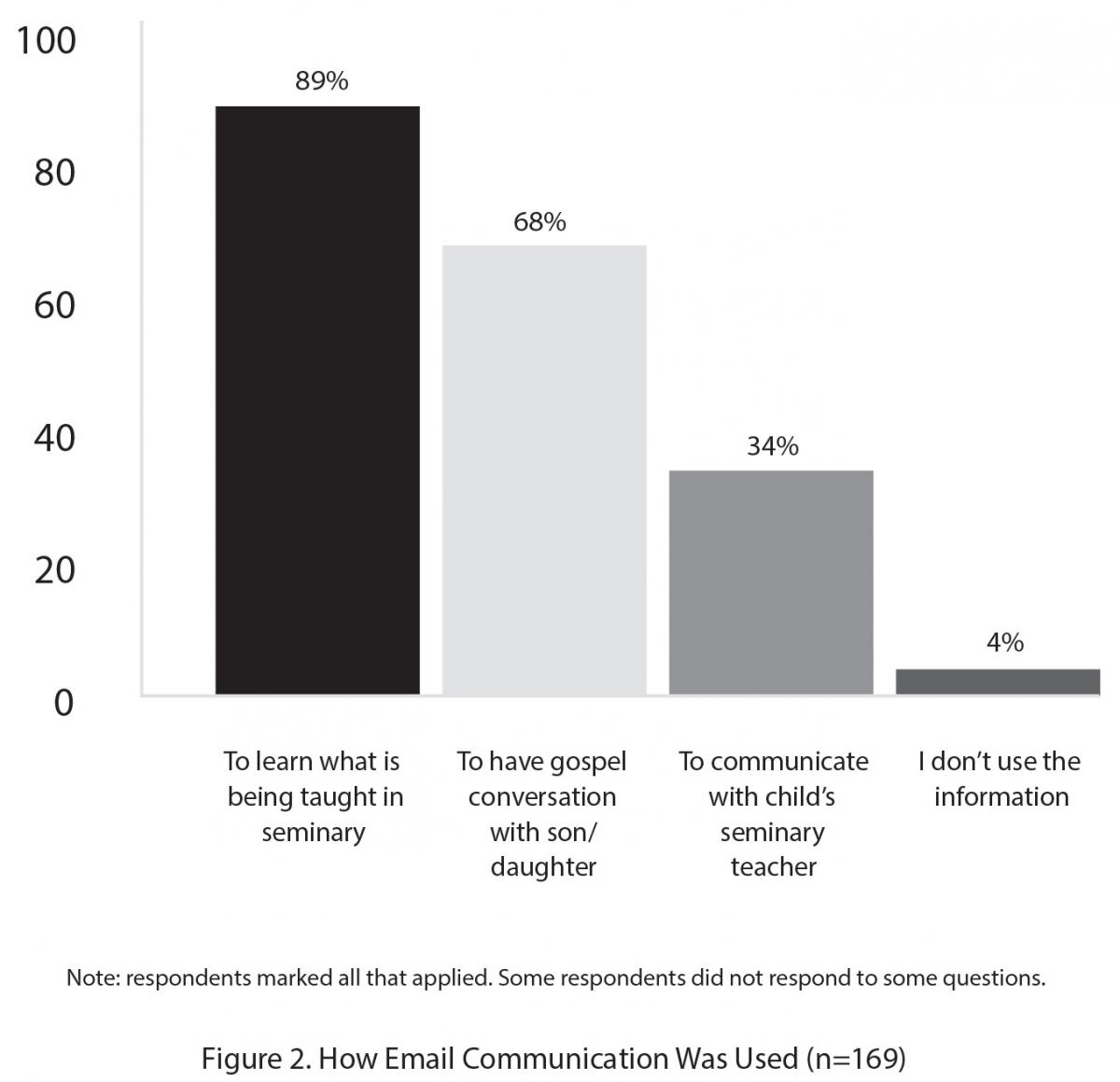 Note: respondents marked all that applied. Some respondents did not respond to some questions.
Note: respondents marked all that applied. Some respondents did not respond to some questions.
How Email Communication Is Valued
Over 80 percent of parents indicated that these email communications were “valuable” or “very valuable” to them (see figure 3). They noted that the emails from the seminary teacher were informative and appreciated. “I love her emails . . . and look forward to [the] information that she provides,” noted one parent. Another expressed the significance of the email communications this way: “I have two children with different teachers so I get to enjoy two different types of emails. This is a fantastic program. Thank you for starting it.” In general, parents saw great value in receiving email updates from seminary teachers: “I love the way my child’s seminary teacher communicates with me now.”
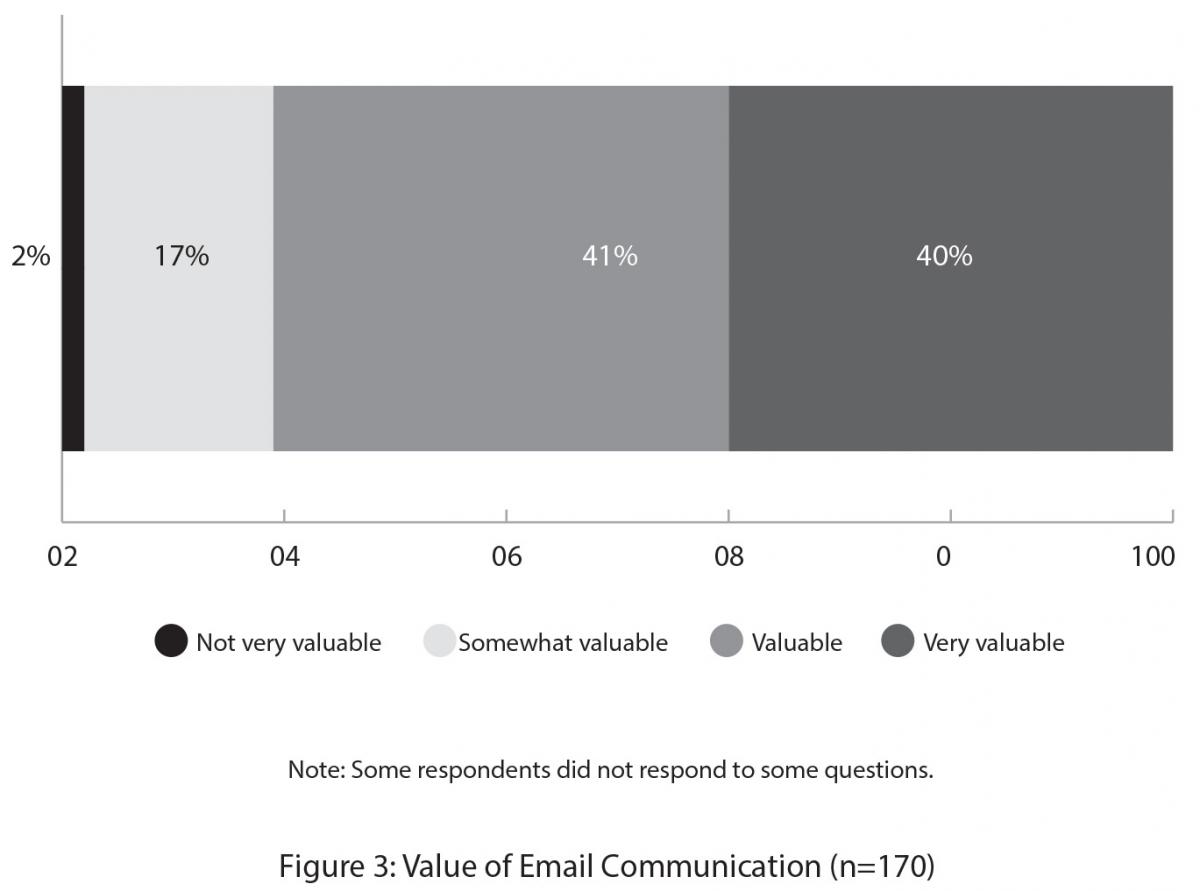 Note: Some respondents did not respond to some questions.
Note: Some respondents did not respond to some questions.
How Email Communication Is Affecting Gospel Conversation at Home
As indicated earlier, seminary teachers included a couple of discussion questions for parents. In reference to these questions, one parent noted, “I especially like the questions he suggests asking students in order to start a conversation.” Another parent said, “It has helped me to know what [my son has] learned. And it has a few times sparked a conversation. [It shocked him] that I knew what [his class] had discussed. He doesn’t communicate much about what happens at school.” The discussion questions from the seminary teachers facilitated family gospel conversations. Elder Marvin J. Ashton noted the following regarding family communications:
Communications in the family will often be a sacrifice because we are expected to use our time, our means, our talent, and our patience to impart, share, and understand. . . . One must be willing to forgo personal convenience to invest time in establishing a firm foundation for family communication. . . . We must realize that communication is more than a sharing of words. It is the wise sharing of emotions, feelings, and concerns. . . . Proper communication will always be a main ingredient for building family solidarity and permanence. . . . Communication can help build family unity if we will work at it and sacrifice for it.[26]
It is wonderful that these emails can establish this firm foundation for family communication.
According to survey responses, 51 percent of parents indicated that the email communication received from the seminary helped to increase gospel conversation at home (see figure 4).
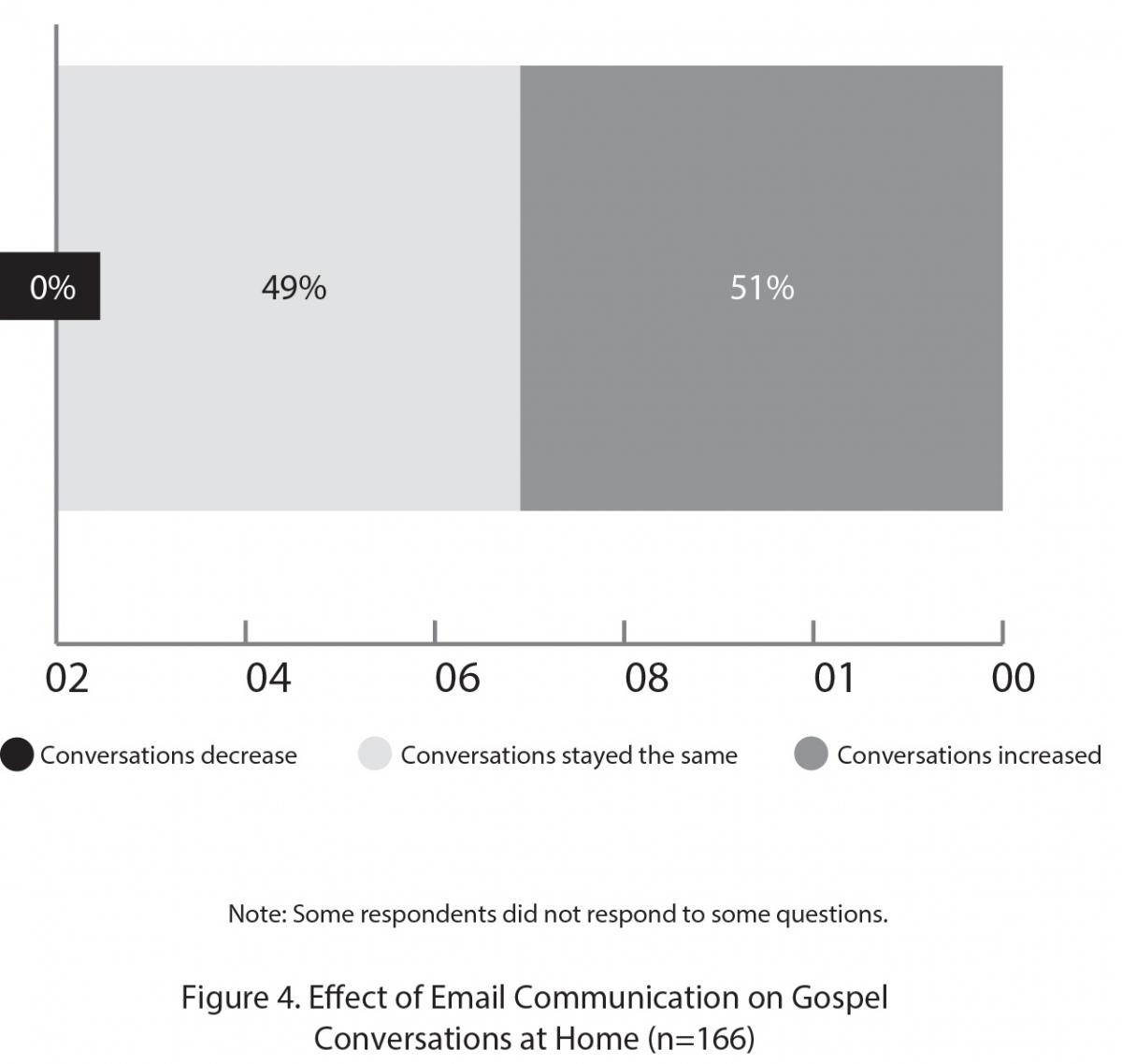 Note: Some respondents did not respond to some questions.
Note: Some respondents did not respond to some questions.
Several parents indicated that the gospel-centered communication in their home was particularly nurturing when seminary emails were short and to the point. One parent noted that “the length of the e-mails I have received from the seminary teacher is just right. It gives me enough to ask my son about his feelings on the subject that they have discussed in class.” Another noted that “it’s brief and to the point, enough to stimulate conversation and keep it simple.” Most parents noted that emails containing a couple of sentences with one or two discussion questions were sufficient.
As the discussion questions in the emails have helped increase gospel conversations, they have blessed both the students and the parents as explained by the following parent: “The emails I receive are relatively to the point and short. It only takes a moment to see what scripture assignment is to be read that day. It’s great because it has gotten me to read the scriptures daily with my child.” A past Ensign article ascertains that “one of the best sources of conversation is the gospel. . . . How many family conversations have been started with the simple question, ‘What did you learn in church [or seminary] today?’ . . . Good conversations [in the home] can become a means of increasing family unity and providing memories that we will treasure throughout our lives.”[27] Elder M. Russell Ballard of the Quorum of the Twelve Apostles taught that “nothing is more important to the relationship between family members than open, honest communication. . . . When long-established patterns of positive communication and faithful example prevail, it is much easier to counsel together.”[28] Many benefits result by providing discussion questions that increase gospel conversations in the home.
Although many of the emails were able to spark gospel conversations between parents and children, a New Era article notes that “meaningful communication doesn’t just happen—it takes practice, practice that you can often initiate.”[29] An article in the Ensign further explains that “healthy communication affects both the heart and the mind.”[30] By providing discussion questions related to seminary lessons, S&I teachers can help to initiate those gospel conversations to help strengthen the relationship between parents and children in the home.
Challenges Related to Email Communication with Parents
It is important to keep in mind that “poor communication often results in disunity, hostility, and a breakdown of trust. Sometimes this causes communication to stop altogether.”[31] Elder David A. Bednar warned that there are potential pitfalls of various technologies in today’s world.[32] S&I leaders and teachers should be aware of communication challenges so that they might consider ways to mitigate those challenges and improve communication. There are also “invisible walls,” and “we must find a way to remove the obstacle, . . . look over the wall, or find a loose brick to let us through, or dismantle it entirely.”[33]
Although there were many positive experiences that came from the weekly emails to parents, there were also some challenges. For example, released-time and stake-called teachers had some difficulty gathering and setting up email lists. In addition, stake-called teachers worried about the time and ability required to compose a weekly email message to parents. Finally, some teachers discussed challenges associated with contacting nonmember parents.
Released-time teachers.
STAR and WISE are computer programs developed by S&I to gather and maintain student information. STAR was gradually phased out and replaced with WISE.) As a result, released-time teachers using STAR experienced some minor difficulties to access, verify, and set up email mailing lists of parents. One teacher explained that “most parents will give us their email on their release form, and we enter them in STAR. Then at the beginning of the year, the secretary gives an excel form to the teachers so they can email parents.” Following the release of WISE, many teachers were able to more easily address this challenge. Teachers indicated that “it is fairly easy [now]” and that “WISE simplified a way to access and email parents.” Their challenge now is to verify and update email addresses in WISE for parents to ensure the email information in the system is accurate.
Coordinators and stake-called teachers.
Coordinators experienced more difficulty sending the weekly email to parents than released-time teachers. Coordinators worked through stake-called teachers to send these weekly emails. Stake-called teachers experienced various challenges in sending weekly emails to parents, such as the difficulty gathering email addresses (particularly from nonmember parents) and consistently sending out the emails each week. In addition, stake-called teachers were worried about their lack of time and competency to compose a weekly summary of the lesson, as well as responding to nonmember parents.
While the coordinator in Boston encouraged stake-called teachers to compose their own weekly emails, the coordinator in Brazil created the initial message and encouraged stake-called teachers to add to or revise a pre-composed message. They noted some challenges in getting stake-called teachers to assist in this effort. The coordinators noted the following:
I asked my volunteer teachers to send a weekly email and . . . only about 1/
3 of stake called teachers [did]. . . . Most teachers had a hard time [getting] . . . parent’s email address. (Boston coordinator) In Brazil, the coordinator emails the volunteer teacher, who emails parents. A few volunteer teachers [less than half] will add something, but most just forward [my email]. (Brazil coordinator)
Coordinators in this pilot study noted that stake-called teachers were concerned about how much time it would take to compose a weekly summary. They were also worried about their ability to compose a competent and coherent email with a summary of the week’s lesson.
For those not participating, the biggest reason for not participating is because it is taxing on their time. Some worry about being able to compose the email . . . [and] their ability to craft a smart, readable email to parents, which can be daunting to volunteer teachers. Some teachers are intimidated to write intelligent emails to parents. (Boston coordinator)
Our volunteer teachers have other jobs and callings. . . . They don’t have time to prepare the summary and send emails. . . . They need help with the summary, and then create the questions. . . . It may be easier to have coordinators create a short summary, and have 1–2 questions, and then have the volunteer teacher to adapt it. It is obviously better for them to do it, but due to time, it is easier for them to forward it. (Brazil coordinator)
Finally, there was a challenge among communication with nonmember parents. This was particularly an issue with S&I teachers outside the United States. The coordinator in Brazil provided the following assessment of this challenge:
Most don’t have parents that are members of the Church, many [nonmember] parents say they don’t know how to do this because they are not members of the Church. Having their children give their parents’ email . . . [is] a concern. [Nonmember] parents were really unsure how they were supposed to help if they are not members of the Church. . . . Some nonmember parents didn’t want to do it, some ok to do it, some nonmember indicated they wouldn’t want to do this [the discussion questions] with their kids. Guessing we have about 40 percent non-member parents. (Brazil coordinator)
Summary
The communication pilot highlighted some of the best practices for communication between S&I teachers and parents, especially for those in released-time programs. Parents indicated that they preferred emails once a week that were short, simple, and easy to read. In addition, they appreciated when these emails had personal and specific information about their children once in a while. These parents valued these emails and used them to learn what was being taught in seminary. The emails also resulted in increased gospel conversations with their children at home. Coordinators indicated additional challenges by stake-called teachers to send a weekly email, noting their lack of confidence to compose a competent email as well as some challenges working with non–Latter-day Saint parents. Overall, pilot participants had a very good experience.
As S&I leaders and teachers seek to improve how they communicate with parents in today’s digital world, it is helpful to remember the counsel from President Lorenzo Snow that “it is your business to find the way to the hearts of those to whom you are called [to serve].”[34] According to a licensed clinical social worker at the LDS Family Services, even though “communication techniques are simple to learn, . . . [they] need to be practiced before they can be used effectively. . . . It is never too late to enhance your communication skills.”[35] These suggestions apply whether we are talking with parents face-to-face or through modern-day digital communication tools. Each teacher should consider how to more effectively communicate with parents in today’s digital world and encourage meaningful gospel conversations in the home.
S&I leaders and teachers have a unique opportunity to communicate with parents and to help them increase gospel conversations with their children at home. “Our communications are at the core of our relationships with others. . . . Therefore, we must be careful [with] not only what we communicate, but also how we do so. Souls can be strengthened or shattered by the message and the manner in which we communicate.”[36] In his 2014 Education Week address, Elder David A. Bednar of the Quorum of Twelve Apostles provided the following suggestions in our communication online: be authentic and consistent, edify and uplift, respect intellectual property, and be wise and vigilant. Elder Bednar closed his address by blessing us to “have eyes to see clearly both the possibilities and pitfalls of the remarkable technologies that are available to us today, that you may increase in your capacity to use these inspired tools appropriately.”[37]
Notes
[1] L. Grant, “‘I’m a Completely Different Person at Home’: Using Digital Technologies to Connect Learning between Home and School,” Journal of Computer Assisted Learning 27, no. 4 (2011): 292–302.
[2] David A. Bednar, “To Sweep the Earth as with a Flood,” address delivered on August 19, 2014, during Education Week at Brigham Young University, Provo, Utah.
[3] Church Educational System (CES), Administer Appropriately: Handbook for CES Leaders and Teachers (Salt Lake City: The Church of Jesus Christ of Latter-day Saints, 2003), 24.
[4] Spencer W. Kimball, “When the World Will Be Converted,” Ensign, October 1974, 10–11.
[5] L. Tom Perry, “Thou Shalt Give Heed unto All His Words,” in Conference Report, April 2000, 27.
[6] Gordon B. Hinckley, “Faith: The Essence of True Religion,” Ensign, November 1981, 5.
[7]“Improving Family Talk,” Ensign, July 1990, 29.
[8] Thomas S. Monson, Improvement Era, February 1969, 4.
[9] The Objective of Seminaries and Institutes of Religion, 2009.
[10] CES, Administer Appropriately, 5.
[11] M. Russell Ballard, “Like a Flame Unquenchable,” in Conference Report, April 1999,112.
[12]“Improving Family Talk.” 28.
[13] Spencer W. Kimball, “Keep the Lines of Communication Strong,” in Conference Report, April 1972, 26.
[14] CES, Administer Appropriately, 5.
[15]“Barriers and Bridges of Communication,” Ensign, January 1985, 530.
[16] CES, Administer Appropriately, 5.
[17] L. Lionel Kendrick, “Christlike Communications,” in Conference Report, October 1988, 30.
[18] Russell Wilcox and Brad Wilcox, “Keep Texting from Taking Over,” New Era, August 2007, 30–33.
[19] Wilcox and Wilcox, “Keep Texting from Taking Over,” 30–33.
[20] Mark Ogletree, “Speak, Listen, and Love,” Ensign, February 2014, 15.
[21] Douglas E. Brinley and Mark D. Ogletree, First Comes Love (American Fork, UT: Covenant Communications, 2002), 123–26.
[22] Ogletree, “Speak, Listen, and Love,” 15.
[23] Jennifer Grace Jones, “No Corrupt Communication,” Ensign, August 2013, 36.
[24] Marshall T. Burton, “Weighing Needs: Communicating the Better Way,” Ensign, February 1972, 18.
[25]“Barriers and Bridges of Communication,” 520.
[26] Marvin J. Ashton, “Family Communications,” in Conference Report, April 1976, 790.
[27]“Improving Family Talk,” 31.
[28] Ballard, “Like a Flame Unquenchable,” 114.
[29] Chris Crowe, “How to Talk to Your Parents,” New Era, February 1989, 16.
[30] Ogletree, “Speak, Listen, and Love,” 15.
[31]“Improving Family Talk,” 28.
[32] David A. Bednar, “Things as They Really Are,” Ensign, June 2010, 16–25.
[33] Brad Wilcox, “Can Your Child Really Talk to You?,” Ensign, September 1995.
[34] Lorenzo Snow, “Instructions to Missionaries,” Improvement Era, December 1899, 128.
[35] C. Ross Clement, “Talking with Teens,” Ensign, June 2005, 35.
[36] L. Lionel Kendrick, “Christlike Communications,” in Conference Report, October 1988.
[37] Bednar, “To Sweep the Earth as with a Flood.”
Communicating With Parents in Today’s Digital World by Po Nien (Felipe) Chou
© 2015 By Intellectual Reserve, Inc.
